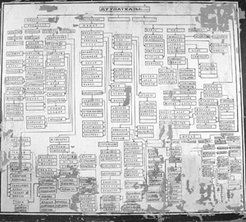The Social Dynamics of Kinship

Kinship is based on two complementary principles: descent and affinity. It is a primary provider of a sense of personal belonging and the basis of the most immediate form of social integration. Kinship most striking in its dynamics: on the one hand, it acts as an institutional framework in all human groups; on the other hand, the ways it is made use of are highly diverse.
The project is focussed on four major topics: kinship as the primary source of identification and group formation; the social relevance of kinship-based groups; alternative forms of identification and group formation and their influence on kinship; the relevance of patterns of identification and relation within human groups to their interaction with the environment. The field data will be collected among the Kyrgyz of the Tian Shan mountain region and compared with existing ethnographic data on clan-based societies.
Kinship strategies may be investigated within two major fields of agency: relations between humans and relations between humans and “non humans” (Schweitzer 2000: 208). As far as the first field is concerned, the project will focus on the “social uses of kinship” (Bourdieu 1980 [2000]) among contemporary Kyrgyz.

Taking into consideration the autonomisation of social fields, I will first try to circumscribe where and why kinship is relevant. Second, I will analyse how kinship relationships are kept in “working order” as well as the strategies for producing, maintaining and transmitting group identity. Third, I will examine the patterns of alliance-making and networking proper to kinship groups and how these groups interrelate to alternative networks of non-kin relationships. Special attention will be paid to the semantic fields of identity concepts, the categories applied in creating “identity” and “difference” and the strategies of inclusion and exclusion as indicators of the ideological setting of social practices (Bourdieu 1980 [2000]: 167f.; Schlee 2004: 141f.).
The ways kinship is applied in relations between humans and “non-humans” have been approached in two different ways in anthropology. In the first approach, it has been established that whether a society allows the substitution of persons and “things” (Strathern 1985) and whether access to resources is made possible through access to services by others or through reified property relations (Schweitzer 2000: 212-213) influence the strategies of kinship groups. According to the second approach (Haudricourt 1962; Descola 2006), identification and relation as fundamental mechanisms of inclusion and exclusion are governed by the same “schemes of the practice”, irrespective of the ontological status of the entities involved (human beings or “non-human” entities”). The present project builds on these approaches and aims at a broad understanding of identification and relation as basic modalities of social existence.

References
Bourdieu P., Le sens pratique. Paris, Les Editions de Minuit, 1980. English translation: The Logic of Practice. Stanford University Press, 2000.
Descola Ph., Par delà nature et culture. Paris, Gallimard, 2006.
Haudricourt A.-G., “Domestication des animaux, culture des plantes et traitement d’autrui”, L’Homme II (1), 1962, pp. 40-50.
Schlee G., "Taking Sides and Constructing Identities: Reflections on Conflict Theory", Journal of the Royal Anthropological Institute, X, 2004; pp. 135-156.
Schweitzer Peter (Ed.), Dividents of kinship. Meanings and uses of social relatedness. Routledge, 2000.
Strathern M., “Kinship and Economy: Constitutive Orders of a Provisional Kind”, Americam Ethnologist, XII (2), pp. 191-209.


